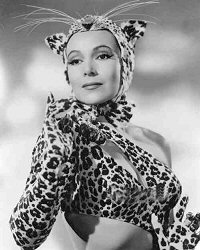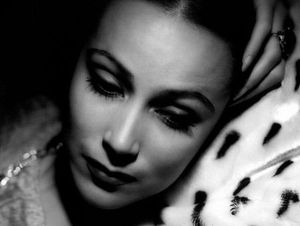Dolores del Rio: Difference between revisions
(Created page with "{{Header|Dolores del Rio 02/22}}{{DEFAULTSORT:Del Rio, Dolores }} {{shp|p1|msh=1}} right ;Date of Birth :3 August 1905, Durango, Mexico ;Date of...") |
m (Text replacement - "screenwriter" to "screenwriter") |
||
| Line 15: | Line 15: | ||
== Mini Biography from www.IMDB.com== | == Mini Biography from www.IMDB.com== | ||
[[image:Dolores_del_Rio.jpg|right|thumb|Dolores Del Rio]] | [[image:Dolores_del_Rio.jpg|right|thumb|Dolores Del Rio]] | ||
Dolores del Rio was the first Mexican movie star with international appeal and had a meteoric career in 1920s Hollywood (an extraordinary accomplishment for a Hispanic female in those years). She came from an aristocratic family in Durango. In the Mexican revolution of 1916, however, the family lost everything they had and emigrated to Mexico City, where Dolores became a socialite. In 1921 she married Jaime Del Rio (also known as Jaime Martinez Del Rio), a wealthy Mexican, and the two became friends with Hollywood producer/director Edwin Carewe. In a somewhat unorthodox manner, for those years, the couple moved to Hollywood where they expected to launch careers in the movie business (she as an actress, he as a screenwriter). Eventually, they were divorced after Dolores made her first film, ''Joanna'' (1925). The film was a success and Dolores was hailed as a female Rudolph Valentino. Her career rose until the arrival of sound in 1928. After a number of forgettable films, she married Cedric Gibbons, the well-known art director and production designer at MGM studios. Dolores returned to Mexico in 1942. Her Hollywood career was over, and a romance with '''Orson Welles''' -- who later called her "the most exciting woman I've ever met"--caused her second divorce. Mexican director Emilio Fernández offered her the lead in his film ''Flor silvestre'' (1943), with a wholly unexpected result: at age 37, Dolores Del Rio became the most famous movie star in her country, filming in Spanish for the first time. Her association with Fernández' team (cinematographer Gabriel Figueroa, writer Mauricio Magdaleno and actor Pedro Armendáriz) was mainly responsible for creating what has been called the '''Golden Era of Mexican Cinema'''. With such pictures as Maria Candelaria (1944), Abandonadas, Las (1945) and Bugambilia (1945), Del Rio became the prototypical Mexican beauty in foreign countries. Her career included film, theater and television. In her last years, she received accolades because of her work for orphaned children. Her last film was ''The Children of Sanchez'' (1978). | Dolores del Rio was the first Mexican movie star with international appeal and had a meteoric career in 1920s Hollywood (an extraordinary accomplishment for a Hispanic female in those years). She came from an aristocratic family in Durango. In the Mexican revolution of 1916, however, the family lost everything they had and emigrated to Mexico City, where Dolores became a socialite. In 1921 she married Jaime Del Rio (also known as Jaime Martinez Del Rio), a wealthy Mexican, and the two became friends with Hollywood producer/director Edwin Carewe. In a somewhat unorthodox manner, for those years, the couple moved to Hollywood where they expected to launch careers in the movie business (she as an actress, he as a [[screenwriter]]). Eventually, they were divorced after Dolores made her first film, ''Joanna'' (1925). The film was a success and Dolores was hailed as a female Rudolph Valentino. Her career rose until the arrival of sound in 1928. After a number of forgettable films, she married Cedric Gibbons, the well-known art director and production designer at MGM studios. Dolores returned to Mexico in 1942. Her Hollywood career was over, and a romance with '''Orson Welles''' -- who later called her "the most exciting woman I've ever met"--caused her second divorce. Mexican director Emilio Fernández offered her the lead in his film ''Flor silvestre'' (1943), with a wholly unexpected result: at age 37, Dolores Del Rio became the most famous movie star in her country, filming in Spanish for the first time. Her association with Fernández' team (cinematographer Gabriel Figueroa, writer Mauricio Magdaleno and actor Pedro Armendáriz) was mainly responsible for creating what has been called the '''Golden Era of Mexican Cinema'''. With such pictures as Maria Candelaria (1944), Abandonadas, Las (1945) and Bugambilia (1945), Del Rio became the prototypical Mexican beauty in foreign countries. Her career included film, theater and television. In her last years, she received accolades because of her work for orphaned children. Her last film was ''The Children of Sanchez'' (1978). | ||
{{wr}} | {{wr}} | ||
Revision as of 22:07, 14 May 2022
Click here for Movie Star category page |
- Date of Birth
- 3 August 1905, Durango, Mexico
- Date of Death
- 11 April 1983, Newport Beach, California, USA. (liver failure)
- Birth Name
- Dolores Martinez Asúnsolo y López Negrete
- Nickname
- Lolita
- Height
- 5' 3½" (1.61 m)
Mini Biography from www.IMDB.com
Dolores del Rio was the first Mexican movie star with international appeal and had a meteoric career in 1920s Hollywood (an extraordinary accomplishment for a Hispanic female in those years). She came from an aristocratic family in Durango. In the Mexican revolution of 1916, however, the family lost everything they had and emigrated to Mexico City, where Dolores became a socialite. In 1921 she married Jaime Del Rio (also known as Jaime Martinez Del Rio), a wealthy Mexican, and the two became friends with Hollywood producer/director Edwin Carewe. In a somewhat unorthodox manner, for those years, the couple moved to Hollywood where they expected to launch careers in the movie business (she as an actress, he as a screenwriter). Eventually, they were divorced after Dolores made her first film, Joanna (1925). The film was a success and Dolores was hailed as a female Rudolph Valentino. Her career rose until the arrival of sound in 1928. After a number of forgettable films, she married Cedric Gibbons, the well-known art director and production designer at MGM studios. Dolores returned to Mexico in 1942. Her Hollywood career was over, and a romance with Orson Welles -- who later called her "the most exciting woman I've ever met"--caused her second divorce. Mexican director Emilio Fernández offered her the lead in his film Flor silvestre (1943), with a wholly unexpected result: at age 37, Dolores Del Rio became the most famous movie star in her country, filming in Spanish for the first time. Her association with Fernández' team (cinematographer Gabriel Figueroa, writer Mauricio Magdaleno and actor Pedro Armendáriz) was mainly responsible for creating what has been called the Golden Era of Mexican Cinema. With such pictures as Maria Candelaria (1944), Abandonadas, Las (1945) and Bugambilia (1945), Del Rio became the prototypical Mexican beauty in foreign countries. Her career included film, theater and television. In her last years, she received accolades because of her work for orphaned children. Her last film was The Children of Sanchez (1978).
- More information is available at [ Wikipedia:Dolores_del_Rio ]
External links
Dolores del Rio at the Internet Movie Database
Chat rooms • What links here • Copyright info • Contact information • Category:Root

